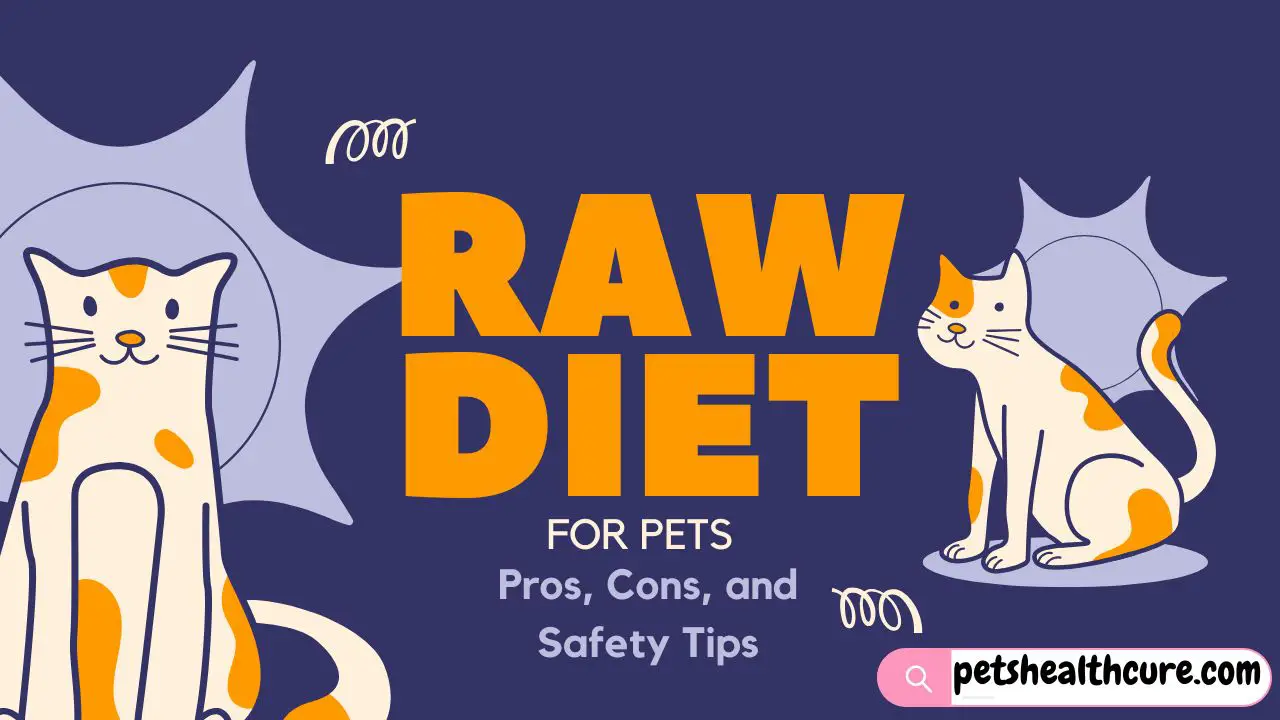Introduction
The raw diet for pets has gained significant popularity among pet owners who believe that feeding raw, unprocessed food can improve their pet’s overall health. While this diet has its advantages, it also comes with potential risks that should not be overlooked. In this comprehensive guide, we will explore the pros, cons, and safety tips for feeding your pet a raw diet. So let’s start and know the Raw Diet for Pets: Pros, Cons, and Safety Tips
What Is a Raw Diet for Pets?
A raw diet for pets, commonly known as BARF (Biologically Appropriate Raw Food) diet, consists of raw meat, bones, fruits, vegetables, and sometimes dairy or eggs. Advocates claim that this diet mimics what pets would eat in the wild, offering numerous health benefits.
Pros of a Raw Diet for Pets
1. Improved Coat and Skin Health
A raw diet is rich in essential fatty acids and amino acids, which contribute to a shinier coat and healthier skin. Many pet owners report that their pet’s fur becomes softer and glossier within weeks of switching to raw food.
2. Better Dental Health
Raw bones serve as a natural toothbrush for pets, helping to remove plaque and tartar buildup. Chewing on raw bones strengthens their jaw muscles and promotes healthy gums, reducing the risk of dental diseases.
3. Enhanced Digestion
Raw food is free from fillers and artificial additives, making it easier for pets to digest. Since it contains natural enzymes and probiotics, it supports gut health and reduces issues like bloating and constipation.
4. Increased Energy Levels
Due to the high-quality protein and natural nutrients found in raw food, pets often experience higher energy levels and improved endurance, making them more active and playful.
5. Reduced Allergies and Food Sensitivities
Many commercial pet foods contain grains, preservatives, and artificial flavors that can trigger allergies. A raw diet eliminates these potential allergens, leading to fewer skin irritations and digestive problems.
6. Stronger Immune System
A raw diet provides essential vitamins, minerals, and antioxidants, which contribute to a stronger immune system. This helps pets fight infections and recover quickly from illnesses.
Cons of a Raw Diet for Pets
1. Risk of Bacterial Contamination
Raw meat can carry harmful bacteria such as Salmonella and E. coli, posing health risks to both pets and their owners. Proper handling and storage of raw food are essential to minimize contamination.
2. Nutritional Imbalances
Without proper planning, a raw diet can lead to nutritional deficiencies or excesses. For example, an unbalanced diet may cause calcium and phosphorus imbalances, leading to skeletal issues.
3. Potential Choking Hazards
Raw bones, if not appropriately selected, can be a choking hazard or cause intestinal blockages. Cooked bones should never be fed, as they splinter easily and can cause internal injuries.
4. Higher Cost and Preparation Time
Feeding raw requires time and effort to source high-quality ingredients, prepare balanced meals, and maintain proper hygiene. Additionally, raw diets can be more expensive than traditional kibble.
5. Not Suitable for All Pets
Some pets, especially those with weakened immune systems, underlying health conditions, or seniors, may not tolerate a raw diet well. It is always advisable to consult a veterinarian before making any dietary changes.
Safety Tips for Feeding a Raw Diet
1. Choose High-Quality Ingredients
Always opt for human-grade meats from reputable sources to ensure that your pet receives fresh and safe food.
2. Handle Raw Food Safely
- Wash your hands thoroughly before and after handling raw food.
- Use separate utensils and cutting boards for raw pet food to prevent cross-contamination.
- Store raw food in airtight containers in the refrigerator or freezer.
3. Ensure a Balanced Diet
A raw diet should include a proper balance of muscle meat, organ meat, bones, and vegetables to meet all nutritional needs. Consulting a pet nutritionist can help formulate a well-balanced diet.
4. Introduce Raw Food Gradually
Abrupt changes in diet can cause digestive upset. Introduce raw food slowly, mixing it with the pet’s current diet and increasing the amount gradually.
5. Monitor Your Pet’s Health
Regular vet checkups and monitoring of weight, stool quality, and energy levels are crucial to ensure that your pet is thriving on a raw diet.
6. Avoid Toxic Foods
Certain foods like onions, garlic, grapes, and chocolate are toxic to pets. Be mindful of what you include in their meals.
FAQs About Raw Diet for Pets
1. Is a raw diet safe for all pets?
Not all pets can tolerate a raw diet, especially those with weakened immune systems or chronic illnesses. Consult a vet before switching.
2. Can I mix raw and dry food?
Yes, but it should be done carefully. Some experts recommend feeding them separately to avoid digestive issues.
3. How do I prevent bacterial contamination?
Proper handling, storage, and hygiene practices such as washing hands and sanitizing food bowls can reduce the risk of bacterial contamination.
4. Can puppies and kittens eat raw food?
Yes, but their diet must be carefully formulated to meet their nutritional needs for growth and development.
5. What are the best meats for a raw diet?
Common choices include chicken, turkey, beef, lamb, and fish. Organ meats like liver and kidneys are also essential for a balanced diet.
Conclusion
A raw diet for pets offers numerous health benefits, from a shinier coat to better digestion. However, it also comes with risks that require careful consideration. If you decide to switch your pet to a raw diet, ensure proper planning, hygiene, and veterinary guidance to provide a safe and balanced meal plan.


